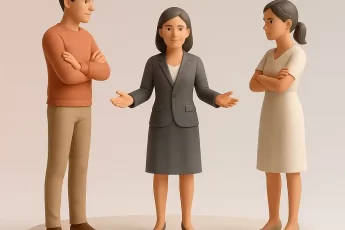In family law, the concept of joint applications for divorce has emerged as a progressive and compassionate approach to ending a marriage. At Midwinters Solicitors in Cheltenham, we recognise the significance of this development and are here to guide you through its intricacies. Whether you’re considering a joint application or navigating the complexities of divorce alone, understanding your options is important.
Understanding Joint Applications for Divorce
The Divorce, Dissolution and Separation Act 2020 brought forth a landmark change in England and Wales divorce law by introducing the possibility of joint applications. Prior to this, one party had to initiate the divorce, often leading to an adversarial process fraught with blame and resentment. Now, both parties can apply together as joint applicants, fostering a more amicable and cooperative environment.
The Process of a Joint Divorce Application
- Initiating the Application:In a joint application, one party, designated as Applicant 1, completes the divorce application and provides a copy to the other party, Applicant 2. Both parties review and sign the document before submission to the court.
- Official Start and Reflection Period:Once the court receives the application, the divorce process officially begins after a two-week initial period. Following this, a mandatory 20-week reflection period allows the couple to consider their decision. This period is crucial for making arrangements concerning children and financial matters.
- Conditional Order Application:After the reflection period, both applicants can jointly apply for a conditional order. This order, previously known as Decree Nisi, signifies the court’s acknowledgment that the couple is entitled to a divorce.
- Court Review and Certificate of Entitlement:The court reviews the conditional order, and if approved, issues a Certificate of Entitlement. This certificate confirms the couple’s right to proceed with the divorce.
- Conditional Order Grant and Financial Arrangements:A six-week period follows the granting of the conditional order, allowing the couple to submit a consent order to make financial agreements legally binding and ensure a clean break if appropriate.
- Final Order Application:Finally, after the six-week period, the couple can apply for the final order (formerly Decree Absolute), which officially ends the marriage. This can be delayed until a financial settlement is agreed especially where there are pensions.
Benefits of Joint Applications
- Reduced Conflict:Joint applications minimise the adversarial nature of divorce. Both parties enter the process with mutual agreement, reducing potential conflicts and emotional distress.
- Transparency and Cooperation:By working together, both parties stay informed and involved throughout the process. This transparency can foster a more cooperative environment, beneficial for negotiations regarding children and finances.
- Emotional Preparedness:Joint applications allow both parties to proceed when they feel emotionally ready. This readiness can lead to smoother negotiations and a less traumatic experience overall.
- Speed and Efficiency:When both parties are in agreement, the divorce process can be expedited, avoiding prolonged disputes and legal battles.
When Joint Applications May Not Be Suitable
Despite the advantages, joint applications may not be appropriate in all circumstances. For instance, in cases involving domestic abuse or where one party is uncooperative, a sole application might be necessary. It’s crucial to seek expert legal advice to determine the best course of action for your specific situation.
Financial and Children Arrangements
Regardless of whether you choose a joint or sole application, arrangements for children and finances must be addressed. Both parties can work together to establish:
- Child arrangements and Maintenance: Deciding on living arrangements and financial support for children can be managed amicably, avoiding court intervention.
- Financial Settlements: Division of assets and property should be agreed upon and formalized through a consent order to ensure legal enforceability.
Costs Involved in a Joint Application
Generally, (Roger- no contested divorces anymore) Costs typically range not much more than £1000+ vat , covering the divorce application fee (£593) and solicitor fees for basic advice and document handling. Importantly, if you seek help with court fees, both applicants must qualify to receive a reduction.
Steps to Take Before Applying
Before initiating a divorce, consider the following:
- Mutual Agreement: Ensure both parties agree on the decision to divorce and are prepared to cooperate throughout the process.
- Method of Application: Decide whether to apply online or by post. Both parties must use the same method.
- Legal Advice: While it’s possible to handle the application yourself, consulting with a solicitor can provide valuable advice and ensure all financial matters are resolved.
Conclusion
The introduction of joint applications for divorce represents a significant step towards a more empathetic and efficient divorce process. By eliminating the need for blame and fostering cooperation, joint applications can reduce the emotional and financial burden on both parties. At Midwinters Solicitors, we are committed to providing the guidance and support you need to navigate this process smoothly. Whether you decide to apply on your own or jointly with your spouse, a joint application could well be the right choice for you, but each situation is different, so it’s important to consider both options before you proceed.
If you are considering a divorce and need expert advice, our specialist family team is here to help. Contact us today for a free initial consultation to discuss your options and find the best path forward for your unique situation.





